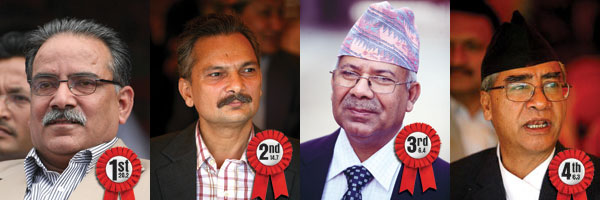 |
Propaganda is part and parcel of political operation. But while the public may be influenced by such propaganda, and indeed by political events, public opinion is not the same as what is touted by political parties. Polls are a means to get to the heart of the matter.
Nationalism threatened or propaganda?
Three quarters of the 5,005 polled felt that Nepali nationalism and its territorial integrity was under threat due mainly to the conflict within and among political parties. It is clear party propaganda has played a role in shaping public perceptions. There hasn't really been serious discussion about Nepali nationalism.
The idea of a people-centred nationalism only entered Nepal following the 1951 revolution, but within a decade, King Mahendra twisted the discourse so political parties and democracy became equated with the threat of India to Nepali nationalism. In this, Nepali communists have proven to be at one with the royalists. This equation was only strengthened over the course of the 30-year Panchayat regime, and was used against the Nepali Congress. The public perception that Nepali nationalism is under threat is a legacy of the same. The political parties must move away from the limited understanding of nationalism as that manifest in street protests, and seek to develop a true nationalism.
People's party and political image
The poll also indicated that Nepal's political parties, including the Maoists, are in transition. This is generally viewed as a positive thing, but is this a sign of true transformation? One cannot hope that the Maoists will transform in the manner UML and NC would like them to. The Maoists have abandoned guns and organised violence while acknowledging multi-party competition, but this in itself is not transformation. It is clear that the Maoists' activities do not hold the same significance for all Nepalis. The Maoists present two contrasting images. One image projected is that of a party that believes in peaceful politics and seeks to uplift the voiceless and the poor. The other is that of a party that believes in violence and the principle of might is right. The public perception of the party is therefore conflicting, and proves that the transition within the party has reached the people. Such a transition can take a long time for a revolutionary communist party, but if this is to be achieved, the party must gradually become more accommodating.
The people rate the Maoists ahead of other parties, though in terms of a good, responsible party, NC is still in the lead. But the lack of support for the latter's leadership indicates that the public values the party's commitment to democracy more than anything else. In any case, the Maoists, NC and UML are still considered the most important political parties. The Madhes-based parties have limited support, even in the Tarai, and are more likely to be involved in the power equations of larger parties than lead national politics themselves.
It is clear that there is a leadership void. When over 5000 respondents were asked to name the leader they most trusted to lead Nepal towards peace, prosperity and democracy, 60 names were thrown up, but all garnered less than 21 per cent of the total votes. This proves there are many politicians, but few who are considered worthy. Maoist leaders Pushpa Kamal Dahal (20.2%) and Baburam Bhattarai (14.7%) may be far ahead of the others, and the party will be happy these two have earned some degree of public trust, but even they don't have much support overall and only 7 Maoist leaders in all make the list.
However, the poll clearly shows up the divided nature of Nepali Congress and UML. Congress leader Sher Bahadur Deuba leads his rivals (6.3%) but with very little overall support, while Sushil Koirala, Ram Chandra Paudel and Gagan Thapa trail him with about the same level of support (<2%). Eighteen Congress leaders make the list, but the votes they received in sum are less than either that received by Pushpa Kamal Dahal or Baburam Bhattarai. It is clear Nepali Congress has to consider the weakness of its leadership, but it appears that there is no more room for family dynasties within the party.
One would think UML would not have a similar problem, having elected new leadership a year ago. The poll exposes the fact that UML continues to be divided. Madhav Nepal still has the strongest support (6.4%), and party president Jhalnath Khanal follows, but with much less support (1.9%). Here, too, 18 leaders make the list, but the total votes received is less than that of the NC leaders.
Poll are not definitive, but they have the capacity to surprise and edify. Taken positively, they can guide political parties. If national politics improve in quality, then the whole nation will benefit.
Youth and instability
Sixty per cent of respondents were aged 18 to 40. And while they offered both negative and positive responses to the questions they faced, in sum their responses were on the negative side. It is a possibility that such negativity and the natural exuberance of youth could be used to destabilise Nepal, particularly in the face of poverty, unemployment, illiteracy and political conflict. Our political parties should be especially careful to mobilise the enthusiasm of Nepali youth in a responsible manner.
READ MORE:
Letting go- By Prashant Jha
Less revolting - By Kiran Nepal
Relief and despair - Publisher's Note
Proximate breakthrough
Get the message across - By Ashutosh Tiwari


